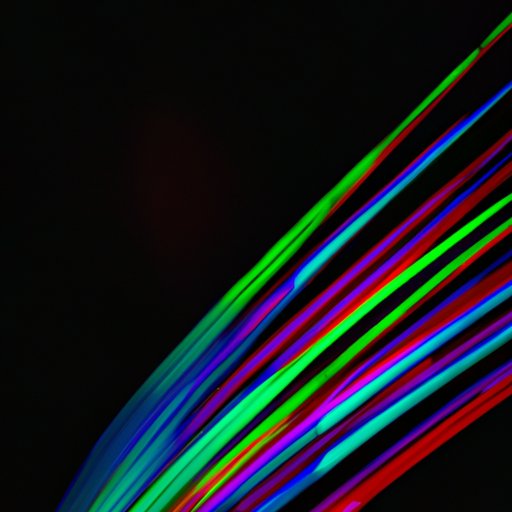Introduction
Light is one of the most fundamental aspects of the universe, and understanding how it travels from a source is important to a range of fields, from astronomy to medicine. Light’s journey has been an object of scientific study for centuries, and it continues to fascinate scientists and researchers today. In this article, we will explore the science of light’s journey, the history of its study, how it can be manipulated and altered, the different types of light sources, and the real-world applications of this concept.
The Science behind Light’s Journey from a Source
Light is a type of electromagnetic radiation that is created when atoms absorb energy and release it as photons. These photons travel through space in waves, with each wave cycle having a specific wavelength, frequency, and speed. The wavelength determines the color of the light, while the frequency determines its energy and brightness. The speed of light is constant and is considered one of the fundamental constants of the universe.
A Historical Approach to Understanding Light’s Journey
The study of light’s journey is a topic that has fascinated scientists and thinkers for centuries. From ancient Greek philosophers to modern quantum physicists, many significant figures have attempted to explain light’s path. Among these key thinkers were Isaac Newton, who demonstrated that white light is made up of different colors, and James Clerk Maxwell, who described light as a form of electromagnetic energy. The ongoing study of light’s journey is a testament to the importance and complexity of this fundamental concept.
Using a Metaphor to Explain Light’s Journey
A helpful metaphor for understanding light’s journey is to think of it as a relay race. The original source, such as a light bulb or star, passes the baton to the medium through which it travels, such as air or glass. The medium then carries the message to its destination, where the light is absorbed, reflected, or refracted. This metaphor is a useful way to think about how light moves through space, even in complex situations such as those involving multiple mediums and reflections.
Light’s Path Alteration and Manipulation
Light’s path can be altered in a variety of ways, including reflection, refraction, diffraction, and scattering. These phenomena occur when light encounters a medium that is different from the one it was traveling through. Reflection occurs when light bounces off a surface, while refraction occurs when light passes through a medium such as water or glass. Diffraction occurs when light encounters an obstacle and bends around it, while scattering occurs when light is dispersed in many different directions. Examples of the consequences of these alterations include optical illusions, such as mirages and rainbows, and the effectiveness of lenses in correcting vision problems.
The Different Types of Light Sources
Light sources can be divided into two main categories: natural and artificial. Natural light sources include the sun, stars, and lightning, while artificial sources include light bulbs and LEDs. Each type of source produces light using different mechanisms, such as nuclear fusion in stars and the flow of electricity through a light bulb filament. Different sources also have different advantages, such as the energy efficiency of LEDs and the brightness of halogen lamps.
Real World Applications of Light Travel from a Source
Applications of the principles of light’s journey can be found in a range of fields, from medicine to astronomy. One example is light therapy, which uses specific wavelengths of light to treat conditions such as depression and acne. Accurate distance measurements, such as those used in astronomy, are also reliant on understanding the properties of light and how it travels. Other real-world applications of light travel from a source include fiber optic communications, laser vision correction surgery, and LED lighting for energy-efficient homes and buildings.
Conclusion
In conclusion, light’s journey from a source is a complex and fascinating topic that spans centuries of scientific study and has numerous real-world applications. Understanding the physics, history, metaphors, sources, and manipulations involved in light’s journey is crucial for a range of fields and industries. From light therapy to energy-efficient lighting solutions, the potential benefits of studying the journey of light from a source are significant. Therefore, it remains an exciting field of study that continues to capture the attention of scientists and researchers today.
(Note: Is this article not meeting your expectations? Do you have knowledge or insights to share? Unlock new opportunities and expand your reach by joining our authors team. Click Registration to join us and share your expertise with our readers.)
